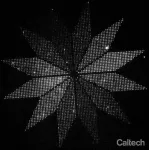Engineers place molecule-scale devices in precise orientation
Proof-of-concept project paves the way for the integration of molecules with computer chips.
2021-02-18
(Press-News.org) Engineers have developed a technique that allows them to precisely place microscopic devices formed from folded DNA molecules in not only a specific location but also in a specific orientation.
As a proof-of-concept, they arranged more than 3,000 glowing moon-shaped nanoscale molecular devices into a flower-shaped instrument for indicating the polarization of light. Each of 12 petals pointed in a different direction around the center of the flower, and within in each petal about 250 moons were aligned to the direction of the petal. Because each moon only glows when struck by polarized light matching its orientation, the end result is a flower whose petals light up in sequence as the polarization of light shined upon it is rotated. The flower, which spans a distance smaller than the width of a human hair, demonstrates that thousands of molecules can be reliably oriented on the surface of a chip.
This method for precisely placing and orienting DNA-based molecular devices may make it possible to use these molecular devices to power new kinds of chips that integrate molecular biosensors with optics and electronics for applications such as DNA sequencing or measuring the concentrations of thousands of proteins at once.
The research, published on February 19 by the journal Science, builds on more than 15 years of work by Caltech's Paul Rothemund (BS '94), research professor of bioengineering, computing and mathematical sciences, and computation and neural systems, and his colleagues. In 2006, Rothemund showed that DNA could be directed to fold itself into precise shapes through a technique dubbed DNA origami. In 2009, Rothemund and colleagues at IBM Research Almaden described a technique through which DNA origami could be positioned at precise locations on surfaces. To do so, they used a printing process based on electron beams and created "sticky" patches having the same size and shape as the origami did. In particular, they showed that origami triangles bound precisely at the location of triangular sticky patches.
Next, Rothemund and Ashwin Gopinath, formerly a Caltech senior postdoctoral scholar and now an assistant professor at MIT, refined and extended this technique to demonstrate that molecular devices constructed from DNA origami could be reliably integrated into larger optical devices. "The technological barrier has been how to reproducibly organize vast numbers of molecular devices into the right patterns on the kinds of materials used for chips," says Rothemund.
In 2016, Rothemund and Gopinath showed that triangular origami carrying fluorescent molecules could be used to reproduce a 65,000-pixel version of Vincent van Gogh's The Starry Night. In that work, triangular DNA origami were used to position fluorescent molecules within bacterium-sized optical resonators; precise placement of the fluorescent molecules was critical since a move of just 100 nanometers to the left or right would dim or brighten the pixel by more than five times.
But the technique had an Achilles' heel: "Because the triangles were equilateral and were free to rotate and flip upside-down, they could stick flat onto the triangular sticky patch on the surface in any of six different ways. This meant we couldn't use any devices that required a particular orientation to function. We were stuck with devices that would work equally well when pointed up, down, or in any direction," says Gopinath. Molecular devices intended for DNA sequencing or measuring proteins absolutely have to land right side up, so the team's older techniques would ruin 50 percent of the devices. For devices also requiring a unique rotational orientation, such as transistors, only 16 percent would function.
The first problem to solve, then, was to get the DNA origami to reliably land with the correct side facing up. "It's a bit like guaranteeing toast always magically lands butter side up when thrown on the floor," says Rothemund. To the researchers surprise, coating origami with a carpet of flexible DNA strands on one side enabled more than 95 percent of them to land face up. But the problem of controlling rotation remained. Right triangles with three different edge lengths were the researchers' first attempt at a shape that might land in the preferred rotation.
However, after wrestling to get just 40 percent of right triangles to point in the correct orientation, Gopinath recruited computer scientists Chris Thachuk of the University of Washington, co-author of the Science paper, and a former Caltech postdoc; and David Kirkpatrick of the University of British Columbia, also a co-author of the Science paper. Their job was to find a shape which would only get stuck in the intended orientation, no matter what orientation it might land in. The computer scientists' solution was a disk with an off-center hole, which the researchers termed a "small moon." Mathematical proofs suggested that, unlike a right triangle, small moons could smoothly rotate to find the best alignment with their sticky patch without getting stuck. Lab experiments verified that over 98 percent of the small moons found the correct orientation on their sticky patches.
The team then added special fluorescent molecules that jam themselves tightly into the DNA helices of the small moons, perpendicular to the axis of the helices. This ensured that the fluorescent molecules within a moon were all oriented in the same direction and would glow most brightly when stimulated with light of a particular polarization. "It's as if every molecule carries a little antenna, which can accept energy from light most efficiently only when the polarization of light matches the orientation of the antenna," says Gopinath. This simple effect is what enabled the construction of the polarization-sensitive flower.
With robust methods for controlling the up-down and rotational orientation of DNA origami, a wide range of molecular devices may now be cheaply integrated into computer chips in high yield for a variety of potential applications. For example, Rothemund and Gopinath have founded a company, Palamedrix, to commercialize the technology for building semiconductor chips that enable simultaneous study of all the proteins relevant to human health. Caltech has filed patent applications for the work.
INFORMATION:
The paper is titled "Absolute and arbitrary orientation of single-molecule shapes." Co-authors at Caltech include Harry Atwater, the Howard Hughes Professor of Applied Physics and Materials Science, and former graduate student Anna Mitskovets (PhD '20). This work was supported by the Office of Naval Research, the Air Force Office of Scientific Research, the National Science Foundation, the Orr Family Foundation, the Abedin Institute, and a Banting Postdoctoral Fellowship.
[Attachments] See images for this press release:

ELSE PRESS RELEASES FROM THIS DATE:
2021-02-18
Inhibitors based on approved drugs and designed to disrupt the SARS-CoV-2 viral protein Mpro display strong antiviral activity both in vitro and in a transgenic mouse model, a new study reports. While vaccines are an important tool in the fight against COVID-19, it remains a high priority to develop antiviral drugs, especially with the rise of variants that may partially evade vaccines. The viral protein Mpro is a protease that is required for cleaving precursor polyproteins into functional viral proteins. This essential function makes it a key drug target. Jingxin Qiao et al. designed 32 ...
2021-02-18
The COVID-19 pandemic's heavy toll on older Americans highlights the need to strengthen the nation's safety net for people in need of long-term services and supports, an Oregon Health & Science University researcher and co-authors argue in a new report published by Milbank Quarterly.
The report proposes a system of universal coverage to support the long-term care of all older Americans.
"This approach would protect against financial catastrophe and end the current system that is based on the need to be financially destitute in order to access coverage via Medicaid," ...
2021-02-18
BOSTON -- COVID-19, the source of the current pandemic, may be caused by a single virus, but it has a variety of presentations that make treatment difficult. Children, for example, almost exclusively experience mild or asymptomatic COVID-19, while adults can develop severe or even fatal COVID-19. But children who contract COVID-19 are at risk for a rare but serious syndrome called multisystem inflammatory syndrome in children (MIS-C). Severe cases of MIS-C can lead to cardiac disease and ventricular failure, and require hospitalization and intense medical support.
Researchers Galit Alter, PhD, core member of the Ragon Institute of MGH, MIT and Harvard, and Lael Yonker, MD, ...
2021-02-18
The effects of selective serotonin reuptake inhibitors (SSRIs) and other conventional antidepressants are believed to be based on their increasing the levels of serotonin and noradrenalin in synapses, while ketamine, a new rapid-acting antidepressant, is thought to function by inhibiting receptors for the neurotransmitter glutamate.
Neurotrophic factors regulate the development and plasticity of the nervous system. While all antidepressants increase the quantity and signalling of brain-derived neurotrophic factor (BDNF) in the brain, the drugs have so far been thought to act on BDNF indirectly, through serotonin or glutamate receptors.
A new study published this week in Cell demonstrates, however, that antidepressants bind directly to a BDNF receptor known as TrkB. This finding challenges ...
2021-02-18
NEW YORK, NY (Feb. 18, 2021)--A new study from Columbia University Vagelos College of Physicians and Surgeons has found that suicide mortality can be reduced by a Federally coordinated approach employing scientifically proven options.
Columbia researchers J. John Mann, MD, Christina A. Michel, MA, and Randy P. Auerbach, PhD, conducted a systematic review, determining which suicide prevention strategies work and are scalable to national levels.
The study, "Improving Suicide Prevention Through Evidence-Based
Strategies: A Systematic Review," was published online in the American Journal of Psychiatry.
The researchers found that screening school children or the general population for those at risk for suicide--the ...
2021-02-18
While the human brain has over 400 miles of total vasculature, little is known about the tiny capillaries that make up much of this intricate labyrinth of blood vessels critical for delivering oxygenated blood and nutrients to billions of brain cells.
According to Dr. Andy Shih, a principal investigator in the Center for Developmental Biology and Regenerative Medicine at Seattle Children's Research Institute, understanding how this vast network regulates blood flow in the brain could hold the key to new treatments for neonatal and childhood neurologic conditions, such as stroke and hypoxia, and issues of aging like dementia and Alzheimer's disease.
"Insufficient blood flow contributes to many of the common neurologic problems seen in children and adults," he said. "Yet, ...
2021-02-18
Acres of asphalt parking lots, unshaded roads, dense apartment complexes and neighborhoods with few parks have taken their toll on the poor. As climate change accelerates, low-income districts in the Southwestern United States are 4 to 7 degrees hotter in Fahrenheit -- on average -- than wealthy neighborhoods in the same metro regions, University of California, Davis, researchers have found in a new analysis.
This study provides the most detailed mapping yet of how summer temperatures in 20 urban centers in California, Nevada, Utah, Arizona, Colorado, New Mexico and Texas affected different neighborhoods between 2018 and 2020. The researchers found even greater heat disparities in California than in other states. The largest disparities showed ...
2021-02-18
PHILADELPHIA (February 18, 2021) - With stressors mounting daily on the health care system due to the COVID-19 pandemic, a de-prioritization of the childbearing family has been noted. Their care has changed, resulting in mothers forced to go through labor and birth without their partners, parents barred from NICU visitation, and discharge of mothers and newborns early without enough expert lactation care. There is great concern that these changes in childbearing families' care may become permanent - to the detriment of the health of both mother and ...
2021-02-18
American values, attitudes and activities have changed dramatically during COVID-19, according to a new study of online behavior.
Researchers from UCLA and Harvard University analyzed how two types of internet activity changed in the U.S. for 10 weeks before and 10 weeks after March 13, 2020 -- the date then-President Donald Trump declared COVID-19 a national emergency. One was Google searches; the other was the phrasing of more than a half-billion words and phrases posted on Twitter, blogs and internet forums.
The study is the lead research article in a special issue of the journal Human Behavior and Emerging Technologies ...
2021-02-18
ORLANDO, Feb. 18, 2021 - University of Central Florida researchers are homing in on the cause of a major disease of sea turtles, with some of their latest findings implicating saltwater leeches as a possible factor.
The disease, known as fibropapillomatosis, or FP, causes sea turtles to develop tumors on their bodies, which can limit their mobility and also their health by interfering with their ability to catch and eat prey.
While the cause of FP isn't known, saltwater leeches have been suspected to play a role due to their frequent presence on areas of sea turtles where FP tumors often develop, such as on their eyes, mouths and ...
LAST 30 PRESS RELEASES:
[Press-News.org] Engineers place molecule-scale devices in precise orientation
Proof-of-concept project paves the way for the integration of molecules with computer chips.



